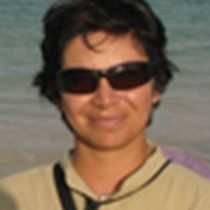San Cristobal Island is located on the southeastern realm of the archipelago and is one of the older islands. We headed ashore this morning, landing on the green sandy beach, and from there we began our hike to the top of a cinder cone.
As we reached the summit, we observed several great frigatebirds flying above our heads. The landscape is very impressive and it looked as if it did not rain at all for a long time. The barren scenery contrasted with the variety of wildlife along the coast.
We saw several Galapagos marine iguanas digging their nests and some were even fighting and chasing each other. At this site, we also spotted several red-footed boobies flying along the cliffs and some were nesting on nearby bushes. This species of booby will nest on trees and bushes, as they are the only species of booby to have prehensile feet.
In the archipelago, we find two different varieties of red footed boobies—one has medium brown-colored plumage, the other has a white body with black feathers on the edges of their wings. Both types have long pointy blue bills and around this area, we have a relatively small colony.
For our guests who wanted a more relaxed morning, we had an optional Zodiac ride along the coast. After these activities, everybody had a great time swimming and snorkeling from the shore. It was nice and sunny morning, and the water temperature was perfect.
This afternoon, we arrived at Cerro Brujo, a site which is known for having one of the most beautiful white sandy beaches in the archipelago. We got ashore and after a relaxing walk along the beach, we went for a well-deserved swim. One of the fabulous aspects is that we shared this beach with Galapagos sea lions, and we had the chance to observe their behaviors—some were sleeping, others nursing and some swimming along the coast.
Towards the end of the afternoon, we had a great sunset while navigating around Kicker Rock and it was our farewell from the archipelago.







